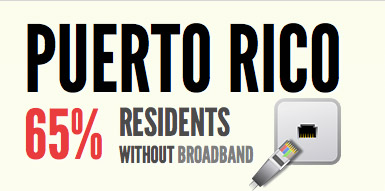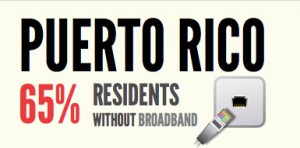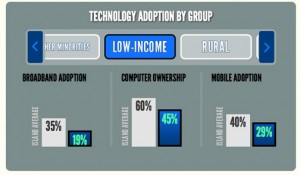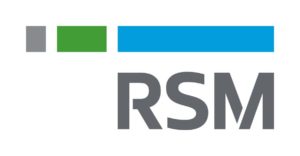Puerto Rico broadband adoption remains slow


The majority of Puerto Rico’s adult population remains disconnected from broadband. (Credit: www.connectpr.org)
Sixty-five percent of Puerto Rico residents have yet to adopt broadband — whether fixed or mobile — dragging significantly behind the U.S. mainland’s average. Despite the lag, the island has made slow but steady progress over the past two years, when high-speed Internet usage increased by four percentage points to 35 percent in 2012, from 31 percent in 2010.
While the island’s adoption rate about half of the U.S. mainland’s 66 percent average, the two-year jump is “very significant” considering that stateside broadband adoption remained stagnant over the same period, said Raquel Noriega, director of public policy for Connect Puerto Rico, a nonprofit organization commissioned by the Puerto Rico Office of the Chief Information Officer to work with all local broadband providers to assess local high-speed Internet adoption.
“Puerto Rico remains behind, which is similar to what we learned in 2010 [when the first study was released],” said Noriega, upon discussing the findings included in the “2012 Connect Puerto Rico Residential Technology Assessment” study released Monday. “However, there has been significant growth, especially when measured against the national average.”
Among other things, the study confirmed that Puerto Rico residents connect to broadband almost equally via cable television infrastructure or through mobile devices. At home, cable companies outpace virtually all other options — including Wi-Fi, DSL and fixed wireless — with 43 percent of subscribers accessing the web that way.
Nearly half of them, or 45 percent, said they signed up because there was a student in the house needing broadband access for school.
“That’s a very significant statistic, as education is something that Puerto Ricans going online care about a lot. It can also be used by education policymakers, as Puerto Rican children are lagging behind other states,” she said.

The broadband adoption gap is particularly acute among certain key demographic groups: 87 percent of seniors; 81 percent of low-income households; and 77 percent of low-income households with children.
Reasons behind ‘non-adoption’
For the second edition of the Connect Puerto Rico Residential Technology Assessment study, the company invested additional resources to determine why island consumers are staying away from broadband services.
Unsurprisingly, failing to find the relevance in the service and affordability issues are the two main stumbling blocks for local broadband growth, Noriega said.
While 23 percent of Puerto Rico adults without a home broadband subscription said there is nothing on the Internet they want to see or use, nearly one-third of non-adopters (32 percent) are “price sensitive,” meaning that they would subscribe to home broadband service if it were offered at a price they considered acceptable.
That target price is $26 per month, which is significantly below the industry’s average rate of $47.30. Offering home broadband service at the lower fee would attract nearly 340,000 price-sensitive non-adopters in Puerto Rico, the study revealed.
“This is not a market price, but it’s telling us something very interesting that broadband providers targeting non-adopters may see as relevant. This is also important for policymakers who may be considering establishing subsidies for this service,” Noriega said.
Mobile access still has room to grow
When it comes to mobile broadband usage, the study showed that 90 percent of island residents have cellphones, but significantly less than half of them — or 35 percent — use their device for Internet access.
In comparison, 55 percent of all U.S. adult cell phone owners report going online using their cell phones, the study showed.






